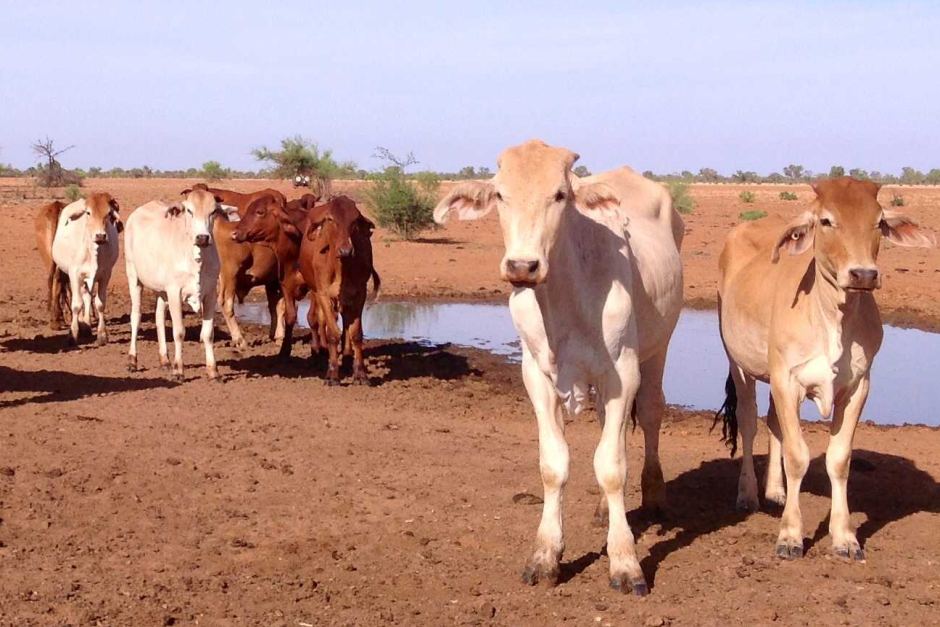The gross value of Australian farm production in 2009-10 was $48.7 billion. So the just announced drought aid package of about $320 million from the federal government is equivalent to 0.6570841889117043% of $48.7 billion.
 Looks like it could be a good year!’
Looks like it could be a good year!’That, ladies and gentlemen of the land, is what you are worth. In other the words, as far as the government is concerned the sustenance and the rebuilding of much of agriculture in Australia after one of the worst droughts in the last 50 years is worth three quarters of five eights of bugger all.
Rural debt is already in excess of $63 billion, so if you borrow another $320 million from the government, you will add 0.5079365079365079% to your debt – but first you have to qualify.
If the qualification criteria are anything like those set for the commonwealth/state funding last year, there won’t be a queue anywhere shortly.
If you want to put the drought aid package into perspective $320 million will pay for one third of a new footy stadium in Perth. Six and a half kilometers of Freeway at $50 million a kilometer or about the same price as it recently cost to upgrade 4.2 kilometers of the Great Eastern Highway.
As many have waited for rain, shot livestock, sold them for next to nothing, taken the kids out of school, done budgets, and talked about next year, should they or should they not try and keep going? I have wondered what this new government, a conservative government will do to ease the problems being faced by so many in rural Australia. This is what agriculture produces for Australia and in exports for the rest of the world:


(Note there is s slight difference in the above gross value of the figures. They both came from ABARES)
Travelling round in Western Australia it’s not difficult to see the affect on small rural towns of 30 years or so of farm aggregation. Farms have doubled in size and families have gone. In some cases schools have closed. Shops are empty, some towns look neglected and many can’t raise a weekend footy team, so they import players from the city to keep the local league going – probably pay them too.
The mantra of the 70s of ‘Get Big or Get Out’ preached by bank managers and farm consultants and amplified a hundred times by the popular rural press made a poorly researched academic theory into what many believed was the only way to survive.
How much use, how effective are the politicians elected by rural constituencies and the extensive and expensive agricultural lobby (MLA, GRDC, NFF; add to the list at will) at getting the true story of Australian agriculture into the heads of the urban politicians who, because of numbers, not because of brains, run the country? On current performance they are about as much use as tits on a bull.
Quite honestly who cares about Holden and QANTAS? One is foreign owned and the other has to face up to competition from foreign government-subsidized airlines.
There is no reason why we should subsidize a car that doesn’t sell; and if we can’t afford to subsidize QANTAS, then we have to let them go and find their money somewhere else. Air travelers being what air travelers are, all but the rich and those on expense accounts will fly by the cheapest airline. ‘The Spirit of Australia’ is sentimental nonsense and political clap-trap.
The difference between Holden and QANTAS and Australian Agriculture is that compared to agriculture, Holden and QANTAS are games of Lego, they don’t grow food and they will never contribute to the national economy in the way that agriculture does.
We will now have to import all of our motor vehicles. Will we ever have to import all of our food? Who knows? Making a living off the land is becoming difficult for many. Working the land is apparently not what many of our young people want.
So maybe in the future it will be Chinese Utes and migrant farmers growing the food? Be like history repeating itself. Great Wall for a Chev and a Chinaman for a Pom.
Saying of the week from Rob Gillam from the Pastoralists and Graziers on hearing the drought relief package offered by the Prime Minister:
“Yes I’m pretty hesitant to give a lot of support to this package. I’m very fearful we’re going back to a business subsidy type circumstances,” he said.
Please explain!



 Looks like it could be a good year!’
Looks like it could be a good year!’
